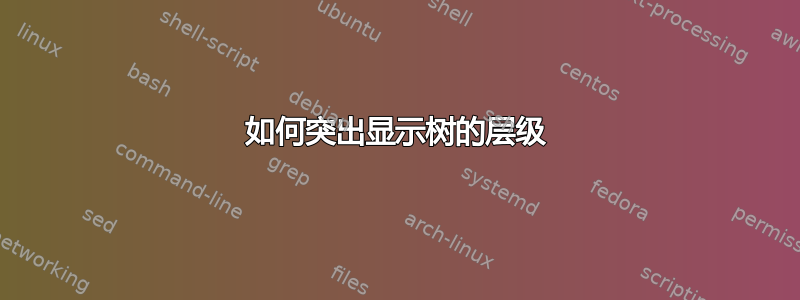
我怎样才能突出显示树的级别,使其看起来像这样......
我用这段代码画了我的树
\documentclass[landscape]{article}
\usepackage[utf8]{inputenc}
\usepackage[T1]{fontenc}
\usepackage{tikz-qtree}
\usetikzlibrary{shadows,trees}
\begin{document}
\tikzset{font=\large,
edge from parent fork down,
level distance=60pt,
every node/.style=
{top color=white,
bottom color=blue!25,
rectangle,rounded corners,
minimum height=8mm,
draw=blue!75,
very thick,
drop shadow,
align=center,
text depth = 0pt
},
edge from parent/.style=
{draw=blue!50,
thick
}}
\centering
\begin{tikzpicture}
\Tree [.Parent
[.one
[.one1
[.one11
[.one111 ]
[.one112 ]
[.one113 ] ]
[.one12 ]
[.one13 ] ]
[.one2 one21 ] ]
[.two
[.two1 two11 ]
[.two2 [.two21 two211 ]
[.two22 [.two221 two2211 ]
[.two222 two321 ] ] ] ]
[.three
[.three1 ] ] ]
\end{tikzpicture}
\end{document}
答案1
一种可能性是命名一些树节点,定义一些辅助节点(用于文本)和坐标,然后使用fit和background库来绘制背景填充(可以使用简化代码\foreach,但这留作练习):
\documentclass{article}
\usepackage[utf8]{inputenc}
\usepackage[landscape]{geometry}
\usepackage[T1]{fontenc}
\usepackage{tikz-qtree}
\usetikzlibrary{positioning,shadows,trees,backgrounds,fit}
\pgfdeclarelayer{background}
\pgfsetlayers{background,main}
\definecolor{myfilling}{RGB}{208,215,222}
\begin{document}
\tikzset{font=\large,
edge from parent fork down,
level distance=60pt,
edge from parent/.style=
{draw=blue!50,
thick
},
filling/.style=
{minimum height=12mm,
draw=myfilling!75!black,
very thick,
drop shadow,
rectangle,rounded corners,
fill=myfilling,
},
ntext/.style=
{draw=none,
text width=4cm,
align=center
},
}
\centering
\begin{tikzpicture}
\begin{scope}[
every node/.style=
{top color=white,
bottom color=blue!25,
rectangle,rounded corners,
minimum height=8mm,
draw=blue!75,
very thick,
drop shadow,
align=center,
text depth = 0pt
},
]
\Tree [.\node (p) {Parent};
[.\node (o) {one};
[.\node (1) {one1};
[.\node (11) {one11};
[.\node (111) {one111}; ]
[.one112 ]
[.one113 ] ]
[.one12 ]
[.one13 ] ]
[.one2 one21 ] ]
[.two
[.two1 two11 ]
[.two2 [.two21 two211 ]
[.two22 [.two221 \node (2211) {two2211}; ]
[.two222 two321 ] ] ] ]
[.three
[.\node (31) {three1}; ] ] ]
\end{scope}
% auxuliary constructs for level 4
\node[left=of 111,ntext]
(text4) {Level 4 text};
\coordinate (aux2) at ([xshift=5pt]31.east|-text4);
% auxuliary constructs for level 3
\node[ntext] at (text4|-11)
(text3) {Level 3 text};
\coordinate (aux4) at ([xshift=5pt]31.east|-11);
% auxuliary constructs for level 2
\node[ntext] at (text4|-1)
(text2) {Level 2 text};
\coordinate (aux6) at ([xshift=5pt]31.east|-1);
% auxuliary constructs for level 1
\node[ntext] at (text4|-o)
(text1) {Level 1 text};
\coordinate (aux8) at ([xshift=5pt]31.east|-o);
% auxuliary constructs for level 0
\node[ntext] at (text4|-p)
(text0) {Level 0 text};
\coordinate (aux10) at ([xshift=5pt]31.east|-p);
% auxuliary constructs for level 5
\node[ntext] at (text4|-2211)
(text5) {Level 5 text};
\coordinate (aux12) at ([xshift=5pt]31.east|-2211);
\begin{pgfonlayer}{background}
\node[filling,fit=(text4) (aux2)] {};
\node[filling,fit=(text3) (aux4)] {};
\node[filling,fit=(text2) (aux6)] {};
\node[filling,fit=(text1) (aux8)] {};
\node[filling,fit=(text0) (aux10)] {};
\node[filling,fit=(text5) (aux12)] {};
\end{pgfonlayer}
\end{tikzpicture}
\end{document}

答案2
我在这里做的是将你创建的树插入到包含黄色条和文本的背景上。必须小心匹配黄色条的正确尺寸(与\rule在内)\crow和间隙大小(\vspace在内\crow)。我还将宽度设置为 9"。
\documentclass[landscape]{article}
\usepackage[utf8]{inputenc}
\usepackage[T1]{fontenc}
\usepackage{stackengine}[2013-09-11]
\usepackage{xcolor}
\newcommand\crow[1]{\colorbox{yellow}{\parbox{9in}{%
\rule[-5pt]{0pt}{25pt}\Huge\bfseries #1\hfill}}\par\vspace*{28pt}}
\usepackage{tikz-qtree}
\usetikzlibrary{shadows,trees}
\begin{document}
\tikzset{font=\large,
edge from parent fork down,
level distance=60pt,
every node/.style=
{top color=white,
bottom color=blue!25,
rectangle,rounded corners,
minimum height=8mm,
draw=blue!75,
very thick,
drop shadow,
align=center,
text depth = 0pt
},
edge from parent/.style=
{draw=blue!50,
thick
}}
\newsavebox{\myboxA}
\newsavebox{\myboxB}
\centering
\sbox{\myboxA}{%
\begin{tikzpicture}
\Tree [.Parent
[.one
[.one1
[.one11
[.one111 ]
[.one112 ]
[.one113 ] ]
[.one12 ]
[.one13 ] ]
[.one2 one21 ] ]
[.two
[.two1 two11 ]
[.two2 [.two21 two211 ]
[.two22 [.two221 two2211 ]
[.two222 two321 ] ] ] ]
[.three
[.three1 ] ] ]
\end{tikzpicture}%
}
\sbox{\myboxB}{\parbox{9in}{\crow{Parent}\crow{Level 1}\crow{Level 2}%
\crow{Level 3}\crow{Level 4}\crow{Level 5}}}
\hsmash{\stackinset{r}{}{t}{3pt}{\usebox{\myboxA}}{\usebox{\myboxB}}}
\end{document}
{tikz-pgf}{graphics}{highlighting}{tikz-trees}

答案3
这只是我通过尝试我为回答另一个问题而编写的包来进行的练习。那个包是justtrees,它是prooftrees我出于沮丧而编写的简化版本。这两个包都提供了一种forest风格,新版本提供了具有各种优点的相应环境。
这使用了软件包的 v0.03 版本。如果您有足够的勇气亲自尝试,请询问!
right justifications开头的调用确保即使不需要任何可见节点right just 1,right just 2也会创建 等。无需添加,left justifications因为left just={<text>}无论如何都会确保这种情况发生。
这些节点会自动命名,然后用于绘制树后面的背景矩形。这必须使用 来完成,forest因为end draw否则,即使我们尝试将它们放置在层上,矩形也会被绘制在树的顶部background。
just format用于指定级别描述符的格式。除其他事项外,这可确保其高度与主树中的节点高度相匹配,这对于获取适当大小的背景矩形是必需的。
我对它的效果感到非常惊讶,说实话,我一分钟都不相信我的代码。
\documentclass[tikz,border=5pt,multi]{standalone}
\usepackage{justtrees}
\usetikzlibrary{shadows,fit,backgrounds}
\tikzset{
my node/.style={
top color=white,
bottom color=blue!25,
rounded corners,
minimum height=8mm,
draw=blue!75,
very thick,
drop shadow,
align=center,
text depth = 0pt,
},
level descriptors/.style={
font=\sffamily,
text=blue!75!black,
minimum height=8mm,
text depth = 0pt,
},
my edges/.style={
draw=blue!50,
ultra thick,
rounded corners
},
my level fill/.style={
draw=blue!75, fill=blue!20, drop shadow, rounded corners
}
}
\begin{document}
\begin{justtree}
{
right justifications,
just format/.append style={level descriptors},
for tree={
my node,
edge={my edges},
edge path={
\noexpand\path [draw, \forestoption{edge}] (!u.parent anchor) -- +(0,-2mm-5pt) -| (.child anchor)\forestoption{edge label};
},
l sep+=2mm,
},
end draw/.code={
\begin{scope}[on background layer]
\foreach \i in {1,...,6}{
\node [my level fill, fit=(left just \i.north west) (right just \i.south east)] {};}
\end{scope}
\end{tikzpicture}
}
}
[Parent, left just=level 1 descriptor
[one, left just=level 2 descriptor
[one1, left just=level 3 descriptor
[one11, left just=level 4 descriptor
[one111, left just=level 5 descriptor]
[one112]
[one113]
]
[one12]
[one13]
]
[one2
[one21]
]
]
[two
[two1
[two11]
]
[two2
[two21
[two211]
]
[two22
[two221
[two2211]
]
[two222
[two321, left just=level 6 descriptor]
]
]
]
]
[three
[three1]
]
]
\end{justtree}
\end{document}



